By the midpoint of the semester, I usually have a sense of what to expect in my courses, and I start to find which topics I'm really enjoying. This semester, my favorite course is probably CEE308: Environmental Engineering Laboratory. When I first enrolled, I wasn't sure exactly what the course would entail—environmental engineering is a broad field, after all, with many possible laboratory experiments. It turns out that we experimentally show many of the concepts I learned about last semester in CEE207: Introduction to Environmental Engineering, which is a really satisfying progression of my studies. For instance, in the first lab we measured the soil partition coefficient of a contaminant, and partition coefficients is a topic Professor Bourg covered and assigned a problem set on last semester in CEE207. I also really like the weekly workflow of this lab course. On Monday, we meet in a classroom with Professor Jaffé, where he discusses the theoretical concepts behind the lab we'll be doing on Wednesday by writing equations and diagrams on the blackboard. On Wednesday, we meet in Professor Jaffé's laboratory to carry out the lab. Sometimes the lab requires measurements on multiple days, in which case we'll also come to the lab over the following days to take readings. Each lab is building towards the final report, which is going to be an Environmental Impact Statement of a hypothetical plan to use golf course pesticides on the Princeton lawns and athletic fields.

I was nervous about the course at the beginning, because I had not-so-fond memories of my previous lab courses, which were remote (holding my breadboard up to a Zoom camera to try to understand why my circuit wasn't working was a bit of a challenge). But in person, I've found that I really love laboratory work, even the problem-solving and explanation-finding of experiments that don't go as planned. During our first lab, for instance, the data showed a mostly horizontal line when we were expecting a linear trend. At first, I thought that maybe my lab group had made an error in the experiment—why doesn't this look how I'm expecting it to look? I showed the results to Professor Jaffé, though, and he helped me realize an explanation for why the trend appeared as it did. We might have carried out the experiment correctly, but the concentrations used may simply have been too high to see the linear trend we expect at low concentrations. In my report, I simply showed the unexpected results and gave my best explanation for what could possibly have caused them. This skill, accepting unexpected results and working to understand them, is likely just as important as understanding the chemical and physical concepts behind the results we expect to get.
As the weather gets nicer, Professor Jaffé is planning to assign experiments that require soil and water samples from around campus. I'm looking forward to this, as an afternoon spent outdoors in the sunshine will be a nice treat midweek as the semester gets more hectic. I have my fingers crossed for nice-weather Wednesdays during the second half of the semester.






